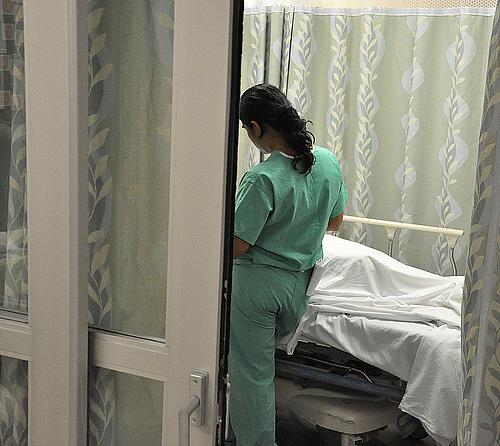Real Challenges Remain in California’s Health Reform Roll-Out

The metaphors typically used to refer to California’s leadership in rolling out Obamacare give some sense of the stakes: “Ground zero,” “bellwether state,” “too big to fail.”
As the state with the largest number of uninsured (around 7 million), California has aggressively moved forward in implementing the Affordable Care Act. It was the first state in the nation to enact legislation creating a state health insurance exchange after the federal law was passed and hasn’t let up since.
“Because we’ve had a positive atmosphere in which to implement in California, our legislature has been very aggressive in implementing Obamacare, but under California rules,” said Richard Figueroa, director of health and human services for The California Endowment, while speaking to a group of journalists at the 2013 National Health Journalism Fellowship in L.A. this week.
But despite a proactive legislature and sympathetic stance toward Obamacare, the state still faces massive hurdles in implementing health reform. The state’s huge, diverse, geographically spread-out population will complicate outreach and enrollment efforts. And California’s estimated 2.6 million undocumented immigrants won’t be covered by the expansion, leaving a large class of uninsured still reliant on emergency rooms and safety-net programs that will receive less funding under Obamacare.
The state received some encouraging news in May when the premiums of plans offered through the state exchange were lower than many analysts expected. But as open enrollment ramps up this fall, real challenges still remain. With Latinos representing about 61 percent of the uninsured in the state, getting as many enrollees as possible in this demographic will be a key test.
“If you’re trying to get to big numbers in California and move the dial on the uninsured, you can’t do it with out working on this group and working on this group rather intensively,” Figueroa said.
To get the word out to more Latinos, The California Endowment teamed with the state health insurance exchange Covered California and Spanish media partners Univision, Telemundo and impreMedia to launch a $70 million advertising campaign called “Asegúrate” or “Get Covered.” President Obama touted the partnership on his California visit last month, saying that the “efforts have already shown some excellent results in the biggest insurance market in the country.”
According to Figueroa, engaging the Latino community is a do-or-die proposition for California’s health reform effort: “If it doesn’t happen in the Latino community, it’s not going to be a success,” he said.
The are other important measures, however, that will indicate whether the health reform roll-out is gaining traction in California. If everything is working properly, Figueroa says, the overall rate of the uninsured should begin to decline, oversight of rates by state regulators should lead to improving rates over time, and more people should begin taking advantage of no-cost preventive health services.
Another key question: Is the state able to recruit and retain outreach assistants and navigators who can walk new enrollees through the process of signing up for insurance? In California, in-person assisters will receive $58 per enrolled application for either the state exchange or Medicaid. An estimated 50 percent to 75 percent of applicants, many speaking languages other than English, will need assistance enrolling.
With strong Democratic majorities in the legislature, California has enacted a spate of laws since 2010 to grease the arrival path of Obamacare.
“We took the stance that we should be incorporating all these federal rules in the state law, because we’re probably going to do a better job of enforcement than the feds are,” said Figueroa, who has spent years in Sacramento crafting health policy for former governors and insurance commissioners. The new laws give the state the ability to take stronger action against insurers and strengthen existing consumer protections.
Once Obamacare is fully implemented and outreach efforts have run their course, Figueroa said an estimated 92 percent of Californians could be insured, leaving 8 percent (3 million to 4 million people) still uninsured.
“If we do a really, really bang-up job on outreach, we’re still going to have millions who are still uninsured in California,” he said.
That remainder of uninsured includes about 2.6 million undocumented immigrants, as well as those who opt to pay the fine rather than purchase insurance under the mandate.
“Does the expansion of Medi-Cal and does the availability of the exchange free up enough money in state budgets or local budgets to start tackling the remaining uninsured?” Figueroa asked.
Not necessarily. More and more Californians insured through the health exchange or Medicaid could prompt dire cuts to state and county safety-net programs left serving a largely undocumented population.
“Let’s face it,” Figueroa said. “Depending on the state, the undocumented may not be very popular, and if that’s all that’s left in a particular program that’s being served, that may put it at some risk.”
If those safety-net programs falter, that could leave counties holding the tab: Barred from preventive care, undocumented patients’ only other option would be the emergency room, an extremely costly last resort that patients typically turn to only in moments of crisis. In counties such as Los Angeles with large undocumented populations, the prospect of relying on emergency rooms to care to such patients already is already cause for alarm.
Of course much still remains uncertain in health reform, except for one thing: All eyes will be on California in the months to come, reading how the country’s most populous state handles one of the biggest policy roll-outs in decades.
Image by Medill DC via Flickr

